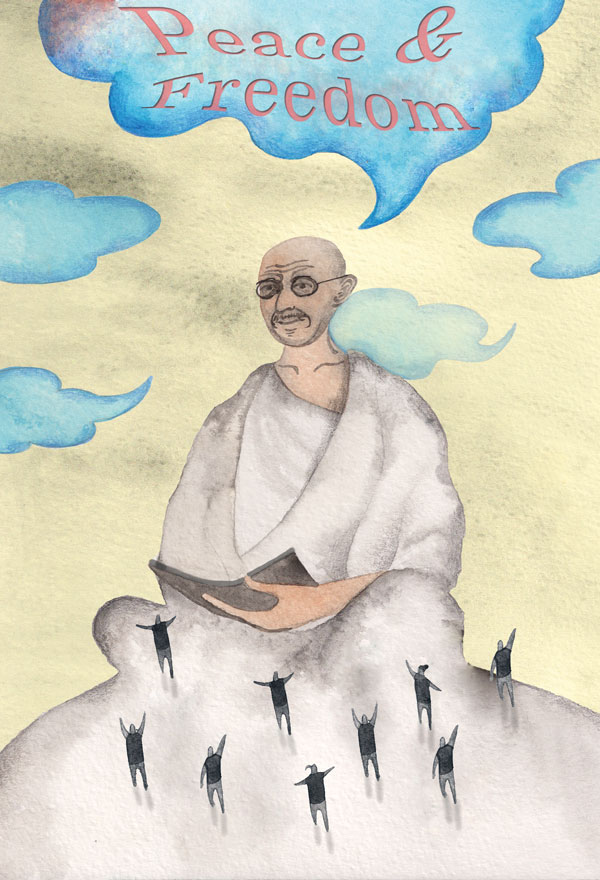By Sanjiv Chopra & David Fisher
If I ask you to conjure up images of exemplary leaders and great leadership moments, from the pages of history or from contemporary times, who comes to mind?
What stories resonate for you?
Let us together embark on this remarkable journey.
Over the past several years, I have had innumerable discussions about great leaders and the qualities that make them singularly qualified to be at the helm. I’ve had these discussions with colleagues, academics, mentors, friends and family throughout the world. All of these treasured experiences have shaped and influenced my own convictions about leadership. I’ve had time to reflect on my childhood, growing up all over India and on the four decades that I’ve lived in the United States, during which I have had the privilege and honor to travel to more than 90 countries in the world. I have met and learned from so many accomplished and gifted individuals.
In this book, I write about the ten key principles of all great leaders, each of them embodied in the word itself: LEADERSHIP. Listening, having Empathy and Compassion, having an Attitude that is upbeat and courageous, Daring to Dream Big, being Effective and Resilient, having a Sense of Purpose, Humility, Integrity and Packing other Peoples Parachutes.
Howard Gardner once said, “Leaders lead in two principled ways, through the stories they tell and the kinds of lives they lead.” In this book, the reader will come across some incredibly engaging and inspiring stories and how often seemingly ordinary folks displayed extraordinary leadership skills.
Daring to Dream Big:
Great leaders have great dreams – and they are decisive. They have a vision of what is possible. Paraphrasing a line from Back to Methuselah by George Bernard Shaw, the U.S. attorney general and presidential candidate Robert F. Kennedy once said, “There are those who look at things the way they are, and ask why? I dream of things that never were, and ask why not?” And father Theodore Hesburgh, the widely respected former president of Notre Dame University, told students there, “The very essence of leadership is that you have a vision. It’s got to be a vision you articulate clearly and forcefully on every occasion. You can’t blow a weak trumpet.”
The British satirist Jonathan Swift wrote, “Vision is the art of seeing things invisible to others.” But remember, in addition to having a clear and compelling vision, one has to have a road map to achieve that vision. A wise old proverb reminds us, “A vision without a plan is just a dream. A plan without a vision is just drudgery. But a vision with a plan can change the world.”
But dreams shouldn’t be limited to the leaders of nations or movements. All of us need to learn how to pay attention to our dreams. Too many of us easily dismiss our own dreams as impossibilities. As the writer Gloria Steinem cautioned, “Without leaps of imagination, or dreaming, we lose the excitement of possibilities. Dreaming, after all, is a form of planning.”
The German writer Johann Goethe once said, “Whatever you can do, or dream you can do, begin it. Boldness has genius, power, and magic in it!”
Sometimes it takes a dreamer to make the dreams of others come true. I have long pointed out that while leaders often have a compelling vision of the future, they also have a clear view of the present. They understand the difficulties of the course they’ve set, but rather than shrinking from a challenge, they embrace it. Henry David Thoreau advised, “If you have built castles in the air, your work need not be lost. That is where they should be. Now go put the foundations underneath.”
It was the great Victorian British poet, Robert Browning, who wrote, “Ah, but a man’s reach should exceed his grasp. Or what’s a heaven for?” But perhaps it was the Danish philosopher and theologian Søren Kierkegaard who said it best, “To dare is to lose one’s footing momentarily. Not to dare is to lose oneself.”
When I’m asked to conjure up my own vision of leadership, what invariably comes to mind is the image of Mahatma Gandhi and the salt march in 1930. It was this epic journey that awakened an entire nation and sparked India’s freedom movement. Natural salt is plentiful in India. It could have been easily collected on the sunbaked beaches, but the British rulers of colonial India had passed a law making it a criminal offense for Indians to pick up that salt for their own use or to sell it. Instead, Indians were forced to purchase imported salt from the British and pay an exorbitant tax on it, a heavy and unjust burden on the average citizen. Gandhi announced he was going to walk 240 miles across India to the ocean, where he would defy the law by picking up Indian salt. If the British soldiers stopped him, he warned, he would not resist. As he wrote to the British leader in India, Viceroy, Lord Irwin, “I cannot intentionally hurt any thing that lives, much less fellow-human beings even though they may do the greatest wrong to me and mine. Whilst therefore I hold British rule to be a curse, I do not intend to harm a single Englishman or any legitimate interest he may have in India…” This letter announced the beginning of Gandhi’s campaign of nonviolent civil disobedience.
His march took twenty-three days and attracted the attention of the world. He chose seventy-eight men to march with him on this historic journey. Every day stories about his march appeared on the front pages of newspapers worldwide. In each village he passed through, thongs of people would join him until his procession was more than two miles long.
Once there, he defied British rule by picking up a small lump of salt. And then he implored other Indians to do the same thing. Eventually Gandhi, as well as an estimated eighty thousand of his followers, were arrested. And when British soldiers brutally attacked unresisting marchers in another town and beat them with clubs, people in America and throughout Europe were captivated and horrified. This was the start of a movement that less than two decades later would result in India becoming independent. And Gandhi’s nonviolent philosophy would become the bedrock of other popular movements throughout the world, especially the civil rights movement in the United States.
While great leaders dream, when it is necessary they can also make daring and difficult decisions. Few were more difficult than that facing General Anthony McAuliffe in December, 1944. (After the successful D-Day invasion) the German army mounted one last counterattack, which became known as The Battle of the Bulge. In the French city of Bastogne the 101st Airborne Division was completely surrounded by a much larger German force. The German General sent an ultimatum to McAuliffe, “There is only one possibility to save the encircled U.S.A. troops from total annihilation: that is the honorable surrender of the encircled town…”
With the lives of his men at stake General McAuliffe’s one word letter in reply has become legend. In his note addressed, “To the German Commander,” he wrote, “NUTS! The American Commander.” The Germans attacked but the valiant 101st proudly rallied behind their leader. Three days later, General George Patton’s Third Army broke through the German ring to relieve McAuliffe’s troops and turn the tide of battle.
Making a firm decision is often the most difficult thing a leader can do; lives and careers may be at stake, but great leadership requires it. In fact, as Napoleon said, “Nothing is more difficult, and therefore more precious, than to be able to decide.”
Decisiveness is absolutely necessary. T. Boone Pickens, the Texas entrepreneur and businessman who founded Mesa Petroleum, advised, “Be willing to make decisions. That’s the most important quality in a good leader. Don’t fall victim to what I call the ready aim-aim-aim syndrome. You must be willing to fire.”
Both managers and leaders make decisions, but there is a singular difference between the two. I once asked Dipak Jain, then the Dean of Northwestern’s Kellogg School of Management, how he would define that difference. “It is simple,” he replied eloquently, “Managers are for today. Leaders are for tomorrow.”
The article is an excerpt from: Leadership By Example: The Ten Key Principles of All Great Leaders, by Dr. Sanjiv Chopra and David Fisher (St. Martins Press 2012)
About the Authors
Dr. Sanjiv Chopra is Professor of Medicine and Faculty Dean for Continuing Education at Harvard Medical School, and Senior Consultant in Hepatology at the Beth Israel Deaconess Medical Center in Boston, Massachusetts. He has more than one hundred publications and four specialist books to his credit. He is the editor-in-chief of the Hepatology Section of UpToDate, an electronic textbook that is subscribed to by more than 450,000 physicians worldwide. With Dr. Alan Lotvin and David Fisher, he is the author of Live Better, Live Longer. He has received numerous awards including the Excellence in Teaching Award from Harvard Medical School. In 2009 he was elected as a Master of the American College of Physicians. He lives in Weston, Massachusetts.
David Fisher is the author of more than fifteen NEW YORK TIMES bestsellers. He lives in New York.



































































